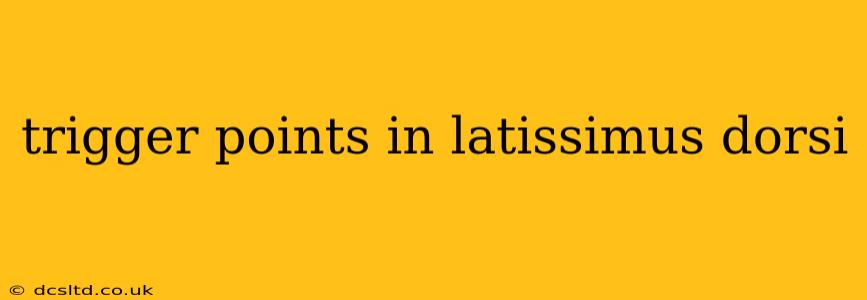The latissimus dorsi (lats), a large, flat muscle spanning the width of your back, plays a crucial role in movements involving your arms, shoulders, and spine. While providing power for actions like swimming and pulling, tight or strained lats can develop trigger points – small, hyperirritable knots within the muscle that cause pain and discomfort radiating to other areas. Understanding the location, symptoms, and treatment options for latissimus dorsi trigger points is essential for managing this common condition.
What are Latissimus Dorsi Trigger Points?
Trigger points in the latissimus dorsi are localized areas of muscle tension and inflammation. These knots feel tight and tender to the touch and can cause referred pain, meaning the pain is felt in areas distant from the actual trigger point. They are often the result of overuse, poor posture, sudden injury, or repetitive strain. The pain can significantly impact your daily activities, limiting your range of motion and causing discomfort.
Where are Latissimus Dorsi Trigger Points Located?
The latissimus dorsi originates from the lower vertebrae of the spine, the iliac crest (hip bone), and the lower ribs. It inserts onto the humerus (upper arm bone). Trigger points can develop anywhere along this muscle, but common locations include:
- Lower back and along the ribs: Pain originating here can feel like a deep ache in the lower back or radiate around the ribs.
- Mid-back: Trigger points in the mid-back section can cause pain that wraps around the side of the body.
- Near the armpit: Pain here often radiates into the arm, sometimes extending down to the hand.
It’s important to note that the pain pattern from latissimus dorsi trigger points can vary depending on the specific location of the trigger point.
What are the Symptoms of Latissimus Dorsi Trigger Points?
Symptoms associated with latissimus dorsi trigger points are diverse and can include:
- Sharp, shooting pain: This pain can be sudden and intense, especially when the muscle is stretched or used.
- Aching, dull pain: A persistent, dull ache is common, especially at rest or with prolonged periods of inactivity.
- Referred pain: Pain can radiate to the lower back, hip, buttocks, lower abdomen, and even down the arm to the hand.
- Muscle weakness: Trigger points can impair the muscle’s ability to function properly, leading to weakness.
- Limited range of motion: Difficulty with arm movements, such as raising your arm overhead or reaching behind your back, is common.
- Stiffness: Feeling stiff in the back, shoulder, or arm.
How are Latissimus Dorsi Trigger Points Diagnosed?
Diagnosing latissimus dorsi trigger points often involves a physical examination by a healthcare professional, such as a physician, physical therapist, or massage therapist. The professional will palpate (feel) the muscle to identify areas of tenderness and tightness. The diagnostic process may also include a review of your medical history and an assessment of your range of motion and posture. Imaging tests are usually not necessary for diagnosis.
What causes Latissimus Dorsi Trigger Points?
- Overuse: Repetitive movements such as swimming, weightlifting, or rowing can lead to strain and trigger point development.
- Poor Posture: Slouching or hunching can put extra strain on the latissimus dorsi.
- Injury: Sudden injuries, such as a fall or a direct blow to the back, can also cause trigger points.
- Stress: While not a direct cause, chronic stress can contribute to muscle tension, increasing the risk of trigger point development.
- Improper lifting techniques: Incorrect lifting mechanics can overwork the lats and cause trigger points.
How are Latissimus Dorsi Trigger Points Treated?
Treatment for latissimus dorsi trigger points aims to relieve pain, reduce muscle tension, and improve range of motion. Common treatment options include:
- Self-massage: Gently massaging the affected area can help alleviate tension.
- Foam rolling: Using a foam roller to apply pressure to the muscle can help release trigger points.
- Stretching: Specific stretches targeting the latissimus dorsi can improve flexibility and reduce pain.
- Heat therapy: Applying heat to the area can relax the muscles and reduce pain.
- Dry needling: This involves inserting thin needles into the trigger points to stimulate muscle release.
- Physical therapy: A physical therapist can develop a personalized exercise program to strengthen the muscle and improve its function.
- Massage therapy: A qualified massage therapist can identify and treat trigger points using various techniques.
Remember, this information is for educational purposes only and should not be considered medical advice. If you suspect you have latissimus dorsi trigger points, it’s crucial to consult a healthcare professional for a proper diagnosis and personalized treatment plan. Early intervention can help prevent long-term problems and improve your overall well-being.
